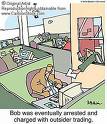I started out as a commodity futures trader in 1986. I was recruited and trained by the staff of a member-broker of the now defunct Manila International Futures Exchange for two weeks. After which, the company already let me out to solicit clients. I still had a basket full of questions that were left unanswered after the training so I had to content myself to doing a lot of research on my own to fully equip myself. Afterwards, I immediately called on close acquaintances, personal contacts, and family friends as I thought that one or two may dabble into this because of personal cognizance. And true enough, one of our family friends did! In fact, the guy was already trading in Copra futures (dried coconut meat from which coconut oil is extracted). He happened to be trading with another company ( also a member broker of MIFE) and was losing heavily. Knowing me personally, he decided to open up an account with me to try me out. We sold the 6 month forward contract of Copra futures and immediately we got caught up in a losing position. We sold the contracts at Php10 at that time when the current price of Copra was only Php6 in the real market. Both the guy and I were baffled by the way the prices at the exchange were moving…they were going up while the actual market price as well as the price of the end product (coconut oil) in the world market were going down. We went through a series of successive margin calls specially when the contract month of our holdings got nearer. What the people at the headquarters did not know was my guy was “loaded” and can absorb the uncanny rise of prices in the exchange. But the most important bit of information the headquarters did not know about my client was the fact he was one of the biggest copra trader in southern Philippines and supplies copra to large multinational companies in Manila.
When the contracts we were holding for six months became spot month, the price went all the way up to Php18 (while the actual market price was only Php5). My client and I already sensed that something was amiss. It was as if the market was doing all it can to break our resolve and get us out of the market and take our loss. So, the last time I went to my client to collect the required deposit to cover the full amount of the contracts, we both decided we will deliver. And when I served notice to the company that my client will deliver, it practically got everyone in the exchange truly worried. I received successive phone calls from my own manager asking me to discourage my client because of “the many obstacles we needed to hurdle to get our deliveries accepted by the exchange.” However, I made it very clear to my manager that my client was unwavering on his decision to make the deliveries. It didn’t make sense then to decide not to deliver because doing so will mean taking a whooping loss. Besides, the price of copra in the world market dropped to only Php5, and if we deliver to the exchange, we will get paid with the contract price of Php10 ( a reasonable profit for the 6 month ordeal the exchange made us go through, so we thought).
My manager decided to visit my client personally. I didn’t know what they talked about since they had a one-on-one session while I was sipping coffee at the hotel lobby. But after their talks, my client gave me specific instructions not to liquidate our positions without a reasonable profit.
In the next few days after that, I saw an unbelievable reversal in the price of the spot month of copra futures. From Php18 it went down to Php12. My manager started calling me again to liquidate our positions. My client and I stood firm. When the price reached Php8, my manager called me again and was practically begging me to liquidate. Sensing the utter desperation in him, I called up my client and we liquidated all our positions.
What a nerve racking experience it was for a neophyte trader like me. It was quite revealing though. I found out so early in my career as a commodity futures trader that prices in the Manila International Futures Exchange could be manipulated.
I got the chance to find out how extensive their scam operations were when I was transfered to the main office after they decided to close the branch I was working in. I shall share them with you in my next blog.

When the contracts we were holding for six months became spot month, the price went all the way up to Php18 (while the actual market price was only Php5). My client and I already sensed that something was amiss. It was as if the market was doing all it can to break our resolve and get us out of the market and take our loss. So, the last time I went to my client to collect the required deposit to cover the full amount of the contracts, we both decided we will deliver. And when I served notice to the company that my client will deliver, it practically got everyone in the exchange truly worried. I received successive phone calls from my own manager asking me to discourage my client because of “the many obstacles we needed to hurdle to get our deliveries accepted by the exchange.” However, I made it very clear to my manager that my client was unwavering on his decision to make the deliveries. It didn’t make sense then to decide not to deliver because doing so will mean taking a whooping loss. Besides, the price of copra in the world market dropped to only Php5, and if we deliver to the exchange, we will get paid with the contract price of Php10 ( a reasonable profit for the 6 month ordeal the exchange made us go through, so we thought).
My manager decided to visit my client personally. I didn’t know what they talked about since they had a one-on-one session while I was sipping coffee at the hotel lobby. But after their talks, my client gave me specific instructions not to liquidate our positions without a reasonable profit.
In the next few days after that, I saw an unbelievable reversal in the price of the spot month of copra futures. From Php18 it went down to Php12. My manager started calling me again to liquidate our positions. My client and I stood firm. When the price reached Php8, my manager called me again and was practically begging me to liquidate. Sensing the utter desperation in him, I called up my client and we liquidated all our positions.
What a nerve racking experience it was for a neophyte trader like me. It was quite revealing though. I found out so early in my career as a commodity futures trader that prices in the Manila International Futures Exchange could be manipulated.
I got the chance to find out how extensive their scam operations were when I was transfered to the main office after they decided to close the branch I was working in. I shall share them with you in my next blog.
(Watch out for my succeeding blogs as they will be more revealing.)




![Reblog this post [with Zemanta]](http://img.zemanta.com/reblog_e.png?x-id=17e24341-83ae-4c85-99bb-287c2c517127)
No comments:
Post a Comment